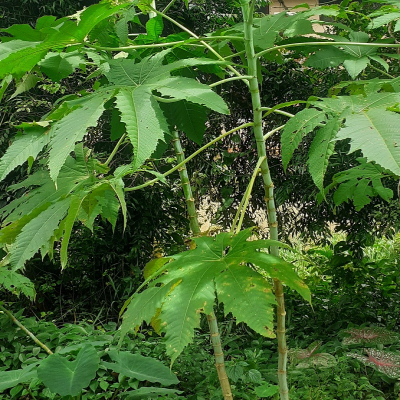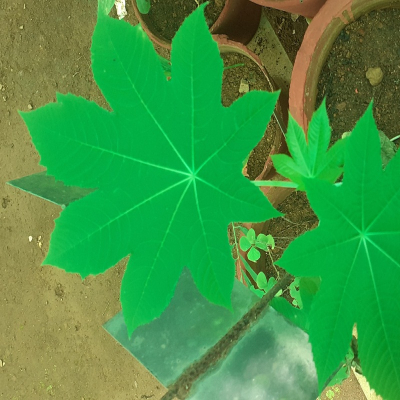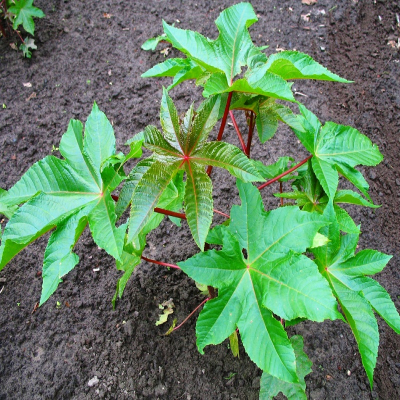Ricinus communis Linn.
Synonyms : Ricinus virids willd. , Ricinus laevis DC
Family : Euphorbiaceae
Group : Anti-arthritic/anti-rheumatic/anti-inflammatory, Hepatoprotective
Parts Used : Leaf , Seed , Flower
Vernacular Names :-
| English | : | Castor |
| Malayalam | : | Avanakku |
| Hindi | : | Erand |
| Sanskrit | : | Erand |
| Bengali | : | Bherenda |
| Kannada | : | Maralu |
| Tamil | : | Amanakku |
Distribution and habitat: Native of N. E. tropical Africa. Found throughout India, cultivated and found wild up to 2400 m.
Botany: A perennial, bushy, soft wooded small tree with a thin grayish brown bark.
- Leaves : Alternate, broad, palmately lobed with 7 or more serrate lobes, petioles with conspicuous glands.
- Flowers : Monoecious in terminal paniculate racemes with crowded male flowers on the upper half of the inflorescence and the pistillate at the basal half.
- Fruits : Globose, Explosively dehiscent, 3-seeded capsules, when young it is covered with fleshy prickles.
- Seeds : Oblong with smooth, Hard mottled crustaceous testa with a white caruncle at the top enclosing oily and fleshy endosperm.
Chemical constituents:
- The bean coat yields lupeol. Roots, stems and leaves contain several amino acids.
- Flowers contain apigenin, chlorogenin, rutin, coumarin and hyperoside.
- Castor oil is constituted by several fatty acids.
- Seed coat contains lipids and higher amounts of phosphatides and non-saponifiable matter than seed kernel.
Uses:
- Remedy for all kinds of rheumatic affections. Useful in gastropathy, constipation, inflammations, fever, ascitis, strangury, bronchitis, cough, leprosy, skin diseases and vitiated conditions of vata, colic, coxalgia and lumbago.
- Castor oil is an excellent solvent of pure alkaloids and such solutions of atropine, cocaine etc. are used in ophthalmic surgery.
- Dropped into the eye to remove the after-irritation caused by the removal of foreign bodies.
Formulations: Eranda-pak, Erandi-muladi-kwath, Rasna-saptak-kwath, Laghu-vis-garva-taila
Agrotechnology
Soil and climate: Castor is cultivated in the plains and the hills. As it has a deep root system it is hardy and capable of resisting drought. It does not withstand waterlogging and frost. It requires a hard dry climate for proper development of fruits and seeds. It needs well-drained soil, preferably sandy loam or loamy sand. High soil fertility is of less importance compared to the good physical condition of the soil. It cannot tolerate alkalinity. It is generally grown in red loamy soils, black soils and alluvial soils.
Propagation: The plant is seed propagated. The seed rate required is 5-12 kg/ha (pure crop) and 3 kg/ha (mixed crop). Seeds are to be sown on a hot bed early in March. The suitable season of growing is kharif season. The crop is usually sown in April and planting is done in early July. The land is to be ploughed 2-3 times with the onset of rains and is repeated after rain. The spacing recommended is 60x90 cm in case of pure crop. It is seldom cultivated as pure but usually grown mixed with crops such as jowar, arhar, chilly, groundnut, cotton, etc.
Manuring: 10-15 tons farm yard manure and 50 kg N, 50 kg P2O5 and 20 kg K2O/ha is recommended. Addition of neem cake is beneficial for higher oil content.
After cultivation: There should be sufficient moisture in the field at the time of sowing. A month after planting, weeding and earthing up is to be done.
Plant protection: The plant is attacked by hairy caterpillar, castor semi-looper, castor seed caterpillar, etc. which can be managed by integrated pest management measures. Spraying with Bordeaux mixture 2-3 times at 15 days interval can control the leaf blight disease.
Harvesting: Harvesting of ripe fruits are done from the end of November till the end of February. The fruit branches are picked when they are still green to avoid splitting and scattering of the seeds. The pods are dried in the sun and seeds are separated by beating with stick and winnowed.
Roots, leaves, flowers, seeds and oil constitute the economic parts.



